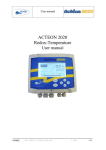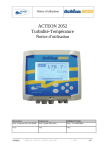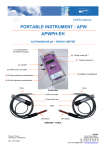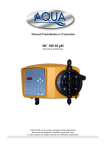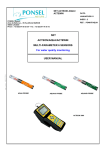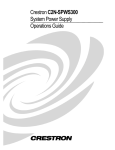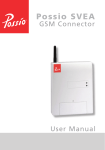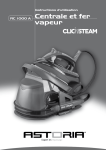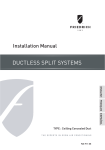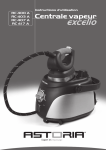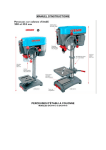Download User manual
Transcript
User manual ACTEON 2010 pH-Temperature User manual WRITTEN BY NAME: STÉPHANE LE GUYADER SIGNATURE: PONSEL REVIEWED BY NAME: PIERRE PECCHIA APPROVED BY NAME: YVAN BOUDEY SIGNATURE: SIGNATURE: Reference: NOTICE_ACTEON_2010_v001-UK V: 001 1/56 User manual IMPORTANT Read the manual carefully before switching the device on. So as to maintain and ensure the good working order of the device, the user must abide by the safety precautions and warnings featured in this manual. Assembly and activation: - Assembly, electrical connection, activation, operation and maintenance of the measuring system must only be carried out by specialist personnel authorised by the user of the facilities. - The specialist personnel must be familiar with this activation manual and are to follow its instructions. - Before carrying out connection, make sure that the power supply is compliant with the directions mentioned on the nameplate. - A clearly signposted current switch must be installed nearby the device. - Before turning the system on, check all the connections. - Do not activate damaged devices; they represent a hazard and should be labelled as faulty. - Repairs must only be carried out by the manufacturer or by a Ponsel after-salesservice. PONSEL Reference: NOTICE_ACTEON_2010_v001-UK V: 001 2/56 User manual CONTENTS 1 THE MEASURING SYSTEM ................................................................................6 1.1 The basic system.................................................................................................................................. 6 1.1.1 A pH and temperature transmitter................................................................................................... 6 1.1.2 A pH sensor................................................................................................................................... 6 1.1.3 A temperature sensor ..................................................................................................................... 6 1.2 Accessories........................................................................................................................................... 7 1.2.1 Consumables ................................................................................................................................. 7 1.2.2 Accessories for a tank-mounted installation without cleaning system .............................................. 7 1.2.3 Accessories for a tank-mounted system with a pH sensor cleaning system....................................... 7 1.2.4 Accessories for the pH filling sensor (PONCPC-PHL-RV-10) ...................................................... 7 1.2.5 Accessories for an installation mounted inside pipes for pH (PONCPC-PHL-10) and Temperature sensors 8 2 INSTALLATION ...................................................................................................9 2.1 Mounting the ACTEON 2000 transmitter box ................................................................................... 9 2.2 Connection of the ACTEON 2010 transmitter to the pH and Temperature sensors ......................... 9 2.2.1 Acteon 2010 wiring...................................................................................................................... 10 2.3 Tank-mounting.................................................................................................................................. 10 2.3.1 Using the stand and protective hood ............................................................................................. 10 2.3.2 Installation of a sensor with a (elbowed or straight) sensor-holder perch and nozzle (PONPPCCPH/EH or PONPPCD-PH/EH).................................................................................................................. 11 2.3.3 Installation of an ESHP (Elbowed Sensor-Holder Perch) or SSHP (Straight Sensor-Holder Perch) on a QRPM (Quick Release Perch Mount) (PONSPFR and PONSPFR2) .......................................................... 13 2.3.4 Installation of a pH sensor cleaning system................................................................................... 14 2.4 Installation mounted inside pipes:..................................................................................................... 15 3 3.1 THE ACTEON 2010 TRANSMITTER.................................................................16 Control console .................................................................................................................................. 16 4 SUMMARY OF ACTEON 2010 MENUS ............................................................17 5 THE MEASURE WINDOW .................................................................................18 6 CALIBRATING THE ACTEON 2010..................................................................19 6.1 Calibrating the sensors...................................................................................................................... 19 6.1.1 Calibrating the pH sensor at two points (complete calibration) ...................................................... 20 6.1.2 Adjusting the slope of the pH sensor ............................................................................................ 23 6.1.3 Returning to theoretical calibration for measurement of pH........................................................... 25 6.1.4 Calibrating the temperature sensor at two points (complete calibration)......................................... 26 6.1.5 Adjusting the slope of the temperature sensor ............................................................................... 29 6.1.6 Returning to theoretical calibration for temperature measurement ................................................. 31 6.2 Information on error messages during calibration of the pH sensor................................................ 32 6.2.1 Error during calibration with the pH 7.01 buffer ........................................................................... 32 6.2.2 Error during calibration with the pH 4.01 buffer ........................................................................... 32 6.3 Information on error messages during calibration of the temperature sensor ................................ 32 6.3.1 Error during calibration at 0°C. .................................................................................................... 32 6.3.2 Error during calibration with water at ambient temperature........................................................... 33 PONSEL Reference: NOTICE_ACTEON_2010_v001-UK V: 001 3/56 User manual 7 VIEWING THE MEASUREMENT HISTORY ......................................................34 8 VIEWING THE SENSOR CALIBRATION REPORT ..........................................35 9 CONFIGURING ACTEON 2000 .........................................................................36 9.1 Configuring the averaging of the sensor response ............................................................................ 37 9.2 Configuring the trend curve.............................................................................................................. 38 9.3 Configuring the two 4-20mA outputs................................................................................................ 39 9.3.1 Adjusting the stopped thresholds for the 4-20mA outputs ............................................................. 40 9.3.2 Calibrating the 4-20mA outputs.................................................................................................... 42 9.4 Adjusting the relay outputs ............................................................................................................... 44 9.4.1 Configuring the relays in mode 1.................................................................................................. 45 9.4.2 Configuring the relays in mode 2:................................................................................................. 46 9.5 Adjusting the measure units:............................................................................................................. 47 9.6 Setting the language: ......................................................................................................................... 48 9.7 Returning to the factory default values:............................................................................................ 49 10 THE INFO MENU ...............................................................................................50 11 ADJUSTING THE CONTRAST OF THE ACTEON 2000 DISPLAY ..................50 12 TECHNICAL SPECIFICATIONS:.......................................................................51 13 THE SENSORS ..................................................................................................51 13.1 The pH sensor.................................................................................................................................... 51 13.1.1 Specifications .............................................................................................................................. 51 13.1.2 Description .................................................................................................................................. 51 13.1.3 Activation.................................................................................................................................... 52 13.1.4 Maintenance ................................................................................................................................ 53 13.1.5 Cleaning ...................................................................................................................................... 53 13.2 The temperature sensor..................................................................................................................... 53 14 QUESTIONS & ANSWERS................................................................................54 14.1 pH measurement anomalies .............................................................................................................. 54 15 APPENDIX .........................................................................................................55 PONSEL Reference: NOTICE_ACTEON_2010_v001-UK V: 001 4/56 User manual Figures Figure 1- Transmitter mounting diagram ........................................................................................................... 9 Figure 2- Installation of a measuring system ...................................................................................................... 9 Figure 3– Installation including a connection box with integrated pre-amplifier ............................................... 10 Figure 4– Mount and hood for the transmitter.................................................................................................. 11 Figure 5- Elbowed Sensor-Holder Perch.......................................................................................................... 11 Figure 6– Nozzle for sensor without cleaning system....................................................................................... 12 Figure 7– Installation of a perch on a QPRM with one or two sliders ............................................................... 13 Figure 8- Installation of a pH sensor mounted inside a pipe.............................................................................. 15 Figure 9- Installation of a temperature sensor mounted inside a pipe ................................................................ 15 Figure 10- Diagram of the pH sensor............................................................................................................... 52 Figure 11- Wiring diagram for the transmitter terminal .................................................................................... 55 PONSEL Reference: NOTICE_ACTEON_2010_v001-UK V: 001 5/56 User manual 1 The measuring system 1.1 The basic system At a minimum, a measuring system requires the following elements: 1.1.1 A pH and temperature transmitter ACTEON 2010 transmitter - pH-meter and thermometer PONACTEON2010 The pH and Temperature transmitter comes complete with a pH 7.01 buffer solution, a pH 4.01 buffer solution, instructions and a CD. 1.1.2 A pH sensor Two sensors are available depending on use: Electrolyte plastogel® pH sensor with 10-metre cable PONCPC-PHL-10 and LEMO connector (perch-mounted or mounted inside a pipe) In cold liquids with very low conductivity (less than 50 µS/cm) or contaminating media, it is recommended to use a filling sensor with bridge. Glass-bodied pH filling sensor with 10- metre cable and PONCPC-PHL-RV-10 LEMO connector 1.1.3 A temperature sensor PONCPC-T-10 PONSEL Temperature sensor with 10-metre cable (perchmounted or mounted inside a pipe) Reference: NOTICE_ACTEON_2010_v001-UK V: 001 6/56 User manual 1.2 Accessories 1.2.1 Consumables PONMANU-2010 PONKCL-1M PONKCL-2M PONKCL-3M PONPEPNET PONSOLCSV PONPH-AMP-4 PONPH-AMP-7 PONPH-AMP-10 Additional User Manual 125-ml bottle of (1M) KCl for pH and Eh filling sensors 125-ml bottle of (2M) KCl for pH and Eh filling sensors 125-ml bottle of (3M) KCl for pH and Eh filling sensors 125-ml bottle of pepsin cleaning solution for Eh and pH sensors 125-ml bottle of storage solution for pH/Eh sensors 125-ml bottle of pH 4 buffer 125-ml bottle of pH 7 buffer 125-ml bottle of pH 10 buffer 1.2.2 Accessories for a tank-mounted installation without cleaning system PON-BJAI-E PH/EH/T PONCBMC-9 PON-ACT-24V PON-PDPCV-1 PON-PDPCV-2 PONPPCC-PH/EH/T PONPPCD-PH/EH/T PONBUSE-PH/EH/T PONCOUDE PONSPFR2C PONSPFR1C PONSPFR-COUL IP 68 leak-tight connection box (complete with 10 metres of cable) with integrated pre-amplifier, for connecting pH/Eh and Temperature sensors over distances greater than 10 metres (see Figure 3 - Installation including a connection box with an integrated preamplifier) 9-conductor screened cable for linking the connection box to ACTEON 2000 Optional 24 VDC power supply PVC stand and protective hood for an ACTEON 2000 transmitter PVC stand and protective hood for two ACTEON 2000 transmitters PVC protective hood for an ACTEON 2000 transmitter PVC protective hood for two ACTEON 2000 transmitters Elbowed sensor-holder perch (ESHP) for pH/Eh or Temperature sensors. Complete with nozzle and glued coupling Straight sensor-holder perch (SSHP) for pH/Eh or Temperature sensors. Complete with nozzle and glued coupling Nozzle for pH/Eh (without cleaning system) or Temperature sensors. Complete with 50 diameter BP3P glued coupling 90° elbow for closing off a sensor-holder perch ESHP or SSHP type mount for 2 perches – 1 arm, 2 sliders – made of stainless steel. ESHP or SSHP type mount for 1 perch – 1 arm, 1 slider – made of stainless steel Additional slider for a QRPM system (Quick Release Perch Mount) 1.2.3 Accessories for a tank-mounted system with a pH sensor cleaning system PONCA-HX1 PONPPCC-PH-NET PONBUSE-PH-NET PONTUBE-NET Air compressor in IP65 casing for permanent cleaning, 230 V power supply (to be used with a perch and nozzle for cleaning) Elbowed sensor holder perch for pH type sensors. Complete with a nozzle housing the cleaning system and rilsan tube pps4 nozzle for pH sensors (with cleaning) 4 x 6 mm black rilsan tube for cleaning system, 7 metres long complete with connector + 3 metres in the perch 1.2.4 Accessories for the pH filling sensor (PONCPC-PHL-RV-10) PONSEL Reference: NOTICE_ACTEON_2010_v001-UK V: 001 7/56 User manual PONRAC-PH/EH-RV PONRES-PH/EH-RV PONROB-PH/EH-RV PONTUB-PH/EH-RV PONCREP-PH/EH-RV Connector for a filling system 5-litre capacity electrolyte tank for a filling system Tap for an electrolyte tank for a filling system 10-metre tube for connecting the tank to the strainer, for a filling system Strainer for a filling system 1.2.5 Accessories for an installation mounted inside pipes for pH (PONCPC-PHL-10) and Temperature sensors PON4020 PON40 PONAP1 PONVCPO-63 PONNIP-PH/EH PONNIP-PH/EH-T PONNIP-T PONSEL Tee assembly fitted with 20 x 27 male/female sockets for AP1. To be fitted on PVC piping 40 diameter glued tee assembly (without connectors) for AP1 Adapter sleeve for pH and temperature sensors mounted inside pipes Stainless steel 63 mm clamp type assembly mounted inside a pipe (316 L) (for MES, OXY, Eh, pH, Temp, C2E and C4E sensors). To be fitted with the appropriate nipple. To be fitted on stainless steel piping Nipple for pH/Eh sensors Nipple for 2 pH/T or Eh/T or pH/Eh sensors Nipple for Temperature sensor Reference: NOTICE_ACTEON_2010_v001-UK V: 001 8/56 User manual 2 Installation 2.1 Mounting the ACTEON 2000 transmitter box Acteon 2000 mounting diagram Dimensions (mm) 2.2 A B C 156.5 181 195.3 Figure 1- Transmitter mounting diagram Connection of the ACTEON 2010 transmitter to the pH and Temperature sensors ACTEON 2010 transmitter, pH-meter and thermometer 230 V~ Earth terminal or lining-out of 230 V Temperature sensor PONCPC-T-10 pH sensor PONCPC-PHL-S10 Relay 4-20 mA Max. 10 metres Figure 2- Installation of a measuring system PONSEL Reference: NOTICE_ACTEON_2010_v001-UK V: 001 9/56 User manual Comment: If the connection cable between the pH sensor and transmitter is longer than 10 metres, a leak-tight IP 68 connection box with integrated pre-amplifier must be used (REF: PON-BJAI-E PH/EH/°C ). ACTEON 2010 pH and Temperature transmitter 230 V~ Earth terminal or lining-out of 230 V Temperature sensor PONCPC-T-10 Relay Max. 10 metres 4-20 mA Connection box PON-BJAI-E PH/EH/°C pH sensor PONCPC-PH-10 Figure 3– Installation including a connection box with integrated pre-amplifier 2.2.1 Acteon 2010 wiring See appendix (§15) at the end of the document. 2.3 Tank-mounting 2.3.1 Using the stand and protective hood A protective hood (PON-PDPVC-1) is available for mounting the ACTEON 2000. The hood is essential in the case of direct exposure to adverse weather or sunshine. PONSEL Reference: NOTICE_ACTEON_2010_v001-UK V: 001 10/56 User manual Figure 4– Mount and hood for the transmitter 2.3.2 Installation of a sensor with a (elbowed or straight) sensor-holder perch and nozzle (PONPPCC-PH/EH or PONPPCD-PH/EH) For immersing the sensor in a tank, it is better to use the elbowed sensor-holder perch: Elbowed Sensor-Holder Perch Liquid level € Sensor-holder perch • Glued coupling ‚ Sensor-holder nozzle ƒ Fixing nut Sensor in nozzle Min. 50 cm Direction of liquid flow Figure 5- Elbowed Sensor-Holder Perch PONSEL Reference: NOTICE_ACTEON_2010_v001-UK V: 001 11/56 User manual Comment: Use an elbowed sensor-holder in tanks that are heavily soiled in order to avoid the build up of fibres on the perch. Installation of the pH sensor in the nozzle: 1) Dismantle the sensor-holder perch then remove the nozzle from the bottom of the perch by removing its tightening screw. 2) Introduce a solid wire into the perch then a string. 3) Take the sensor and remove its protective casing and two ring-type joints. Henceforth, handle the sensor with care. Breakage of the glass bulb is not covered by the guarantee. 4) Attach the end of the sensor to the string and lower it from the top to the bottom of the perch by pulling on the string. 5) Remove the string then place the sensor in the nozzle and let it protrude by around twenty centimetres. 6) Replace only the ring-type joint nearest to the glass part. 7) Leave the tip of the sensor flush with the end of the nozzle, to within a millimetre. Fasten the sensor in place by screwing the tightening screw. 8) Replace the nozzle on the perch and fasten it using the tightening screw. 9) Set the perch in a vertical position using our stand with slider or other sort of system. Adjust the immersion parameters so that the nozzle always remains immersed and so that the more than 0.50 cm is immersed. 10) Position the sensor so that direction of liquid flow comes from behind the nozzle in order to avoid the build up of fibres. Diagram of the sensor in the nozzle without the cleaning system. Tightening screw Water earth cable Nozzle (PONBUSE-PH/EH/T) pH SENSOR (PONCPC-PHL-10) Figure 6– Nozzle for sensor without cleaning system Comment: The line out cable is to be connected to the ACTEON 200 earth terminal. PONSEL Reference: NOTICE_ACTEON_2010_v001-UK V: 001 12/56 User manual 2.3.3 Installation of an ESHP (Elbowed Sensor-Holder Perch) or SSHP (Straight Sensor-Holder Perch) on a QRPM (Quick Release Perch Mount) (PONSPFR and PONSPFR2) 1) Fix the stainless steel QRPM to the infrastructure. 2) Next, fix a sensor-holder perch to the stainless steel QRPM as shown in the diagram below. Figure 7– Installation of a perch on a QPRM with one or two sliders It is possible to install a second slider in order to install a second sensor-holder perch for the temperature sensor (see diagram above). PONSEL Reference: NOTICE_ACTEON_2010_v001-UK V: 001 13/56 User manual 2.3.4 Installation of a pH sensor cleaning system So as to lengthen the time between each clean, use the compressed air cleaning system (PONCA-HXI). 1) Dismantle the sensor-holder perch then remove the nozzle from the bottom of the perch by removing its tightening screw. 2) Introduce a solid wire into the perch then a string. 3) Take the sensor and remove its protective casing and two ring-type joints. Henceforth, handle the sensor with care. Breakage of the glass bulb is not covered by the guarantee. 4) Attach the end of the sensor to the string and lower it from the top to the bottom of the perch by pulling on the string. 5) Remove the string then place the sensor in the nozzle and let it protrude by around twenty centimetres. 6) Replace only the ring-type joint nearest to the glass part. 7) Leave the tip of the sensor flush with the end of the nozzle, to within a millimetre. Fasten the sensor in place by screwing the tightening screw. 8) Replace the nozzle on the perch and fasten it using the tightening screw. 9) Set the perch in a vertical position using our stand with slider or other sort of system. Adjust the immersion parameters so that the nozzle always remains immersed and so that the more than 0.50 cm is immersed. 10) Position the sensor so that direction of liquid flow comes from behind the nozzle in order to avoid the build up of fibres. pH SENSOR (PONCPC-PHL-10) Compressed air duct PONSEL Reference: NOTICE_ACTEON_2010_v001-UK V: 001 14/56 User manual 2.4 Installation mounted inside pipes: For installations mounted inside pipes, use the tee assembly (PON-4020) and the adapter sleeve (PONAP1). pH sensor (PONCPC-PHL-10) Sleeve (PONAP1) Tee (PON4020) 20 x 27 connector Figure 8- Installation of a pH sensor mounted inside a pipe Capteur pH (PONCPC-T-10) Foureau (PONAP1) T (PON4020) Raccord 20x27 Figure 9- Installation of a temperature sensor mounted inside a pipe PONSEL Reference: NOTICE_ACTEON_2010_v001-UK V: 001 15/56 User manual 3 The ACTEON 2010 transmitter 3.1 Control console 7 5 3 1 4 2 6 8 PONSEL 1 ENTER key for accessing menus or validating actions 2 ESC key for exiting menus or cancelling actions 3 € key to move left in menus 4 • key to move right in menus 5 ‚ key to increase a value or select the menu above 6 ƒ key to decrease a value or select the menu below 7 Control screen 8 Quarter turn to lock the cover Reference: NOTICE_ACTEON_2010_v001-UK V: 001 16/56 User manual 4 Summary of ACTEON 2010 menus pH sensor HISTORY Gain adjust (§6.1.2) Complete calibration (§6.1.1) CALIBRATION Theoretical calibration (§6.1.3) CALIBRATION LOGGER Temperature sensor Gain adjust (§6.1.5) Complete calibration (§6.1.4) Theoretical calibration (§6.1.6) Graphic screen adjustment (§9.2) CONFIGURATION MEASURE 4-20mA outputs adjustment Config. of 4mA & 20mA stop switches (§9.3.1) Calibration of 4-20mA outputs (§9.3.2) Adjustment of thresholds to mode 1 (§9.4.1) Relays adjustments Adjustment of thresholds to mode 2 (§9.4.2) Configuration of the measure unit (§9.5) Configuration of the language (§9.6) GENERAL INFORMATION PONSEL Factory default configuration reminder (§ 9.7) Reference: NOTICE_ACTEON_2010_v001-UK V: 001 17/56 User manual 5 The measure window In measure mode the measure screen displays various information: 6 ACTEON 2010 pH meter MEASURE 4.31 pH 8 pH ! MEAS HIST CAL LOG Mode1 R1 R2 CONF 1 The pH measurement (offset in temperature) 2 Indicator of measurement status: ! ! 2 20.00 °C 6 -24h CAL 1 3 4 INFO 5 CAL THEOR : This icon signifies that the calibration coefficients are the theoretical coefficients CAL : This icon signifies that the calibration point of the sensor is not correct. : If there is no icon, this means that the last calibration is correct. 3 Temperature transmitted by the temperature sensor If the sensor is not installed or the wiring is faulty, the temperature is not displayed and the temperature offset is brought down to 20°C. 4 Status and operating mode of relays R1 and R2: 5 ACTEON menu 6 Trend curve configurable from 1 minute to 24 hours (with automatic scaling) The contact is inactive. The contact is active. PONSEL Reference: NOTICE_ACTEON_2010_v001-UK V: 001 18/56 User manual 6 Calibrating the ACTEON 2010 6.1 Calibrating the sensors In the measure window, select the calibration menu: ACTEON 2010 pH meter MEASURE 4.31 pH 20.00 °C pH Mode1 -24h MEAS HIST CAL LOG CONF R1 R2 INFO € Use the • and € keys to move about the ACTEON menu. € Select the CAL menu then press the ENTER key. CALIBRATION SENSORS CALIBRATION SENSOR pH € Gain adjust • Complete calibration • Theoretical calibration TEMPERATURE SENSOR • Zero rectification • Complete calibration • Theoretical calibration ENTER: Validate the choice PONSEL Reference: NOTICE_ACTEON_2010_v001-UK V: 001 19/56 User manual 6.1.1 Calibrating the pH sensor at two points (complete calibration) The following procedure enables complete calibration of your pH sensor. It is necessary to use the 7.01 and 4.01 or 10.01 buffer solutions for this procedure. CALIBRATION SENSORS CALIBRATION SENSOR pH € Gain adjust • Complete calibration • Theoretical calibration TEMPERATURE SENSOR • Gain adjust • Complete calibration • Theoretical calibration € Use the ‚ and ƒ keys to select the type of calibration and sensor to be calibrated. ENTER: Validate the choice € Select the • Complete calibration menu then press the ENTER key. CALIBRATION OF THE SENSOR pH Enter your name: Durant € Use the •and€ keys to move in the name. Use the ‚andƒ keys to change the letters. ESC: Cancel the procedure ENTER: Start calibration € Once you have entered your name or reference, press the ENTER key. Immerse the sensor in the pH 7.01 buffer solution PONSEL Reference: NOTICE_ACTEON_2010_v001-UK V: 001 20/56 User manual CALIBRATION OF THE SENSOR pH Immerse sensor in a 7.01 pH buffer Standard: Measure: : 7.01 7.15 pH pH WAIT, Nonstable measurement € Use the ‚andƒ keys to adjust the value of the buffer. ESC: Cancel the procedure ENTER: Validate pH 7 „ AWAIT MEASUREMENT STABILISATION. € To validate the first calibration point, press the ENTER key. Calibration Correct No € If the first calibration point is not correct, an error message window appears (see "information on error messages” chapter §6.2). Yes Immerse the sensor in the pH 4.01 or 10.01 buffer solution. CALIBRATION OF THE SENSOR pH Immerse sensor in a pH 4.01 or 10.01 buffer pH Standard 4.01 pH : 4.20 Measure WAIT, Nonstable measurement ESC: Leave the current gain ENTER: Validate the new gain € Use the ‚andƒ keys to adjust the value of the buffer (from 4.98 to 10.13). „ AWAIT MEASUREMENT STABILISATION . € To validate the second calibration point, press the ENTER key. PONSEL Reference: NOTICE_ACTEON_2010_v001-UK V: 001 21/56 User manual . Calibration Correct No € If the second calibration point is not correct, an error message window appears (see "information on error messages” chapter §6.2.2). Yes ACTEON 2010 pH meter MEASURE 4.01 pH 20.00 °C pH Mode1 -24h MEAS PONSEL HIST CAL LOG CONF R1 R2 INFO Reference: NOTICE_ACTEON_2010_v001-UK V: 001 22/56 User manual 6.1.2 Adjusting the slope of the pH sensor If you observe a small measurement error, you may only adjust the slope of your sensor by implementing the following procedure: CALIBRATION SENSORS CALIBRATION SENSOR pH € Gain adjust • Complete calibration • Theoretical calibration TEMPERATURE SENSOR • Gain adjust • Complete calibration • Theoretical calibration € Use the ‚ and ƒ keys to select the type of calibration and sensor to be calibrated. ENTER: Validate the choice € Select the • Gain ENTER key. adjust menu then press the Immerse the sensor in the pH 4.01 or 10.01 buffer solution. CALIBRATION OF THE SENSOR pH Immerse sensor in a pH 4.01 buffer Standard : Measure : WAIT, 4.01 4.20 pH pH Nonstable measurement ESC: Leave the current gain ENTER: Validate the new gain € Use the ‚andƒ keys to adjust the value of the buffer (from 4.00 to 10.98). „ AWAIT MEASUREMENT STABILISATION. € To validate the gain adjustment, press the ENTER key. PONSEL Reference: NOTICE_ACTEON_2010_v001-UK V: 001 23/56 User manual Calibration Correct No € If the second calibration point is not correct, an error message window appears (see "information on error messages” chapter §6.2.2). Yes ACTEON 2010 pH meter MEASURE 4.01 pH 20.00 °C pH Mode1 -24h MEAS PONSEL HIST CAL LOG CONF R1 R2 INFO Reference: NOTICE_ACTEON_2010_v001-UK V: 001 24/56 User manual 6.1.3 Returning to theoretical calibration for measurement of pH The theoretical calibration enables a return to the theoretical coefficients (Nernst slope and zeroing the pH sensor offset). Follow the instructions below to carry out a theoretical calibration: CALIBRATION SENSORS CALIBRATION SENSOR pH € Gain adjust • Complete calibration • Theoretical calibration TEMPERATURE SENSOR • Gain adjust • Complete calibration • Theoretical calibration € Use the ‚ and ƒ keys to select the type of calibration and sensor to be calibrated. ENTER: Validate the choice € Select the • Theoretical press the ENTER key. CALIBRATION calibration menu then THEORETICAL CALIBRATION ATTENTION, you will erase your calibration coefficients to return to the theoretical coefficients! € Yes € No € Esc: Cancel the procedure Enter: Validate the choice Use the ‚andƒkeys to select and confirm the procedure. € After correctly selecting € Yes to return to the theoretical coefficients, press the ENTER key. ACTEON 2010 pH meter MEASURE 5.42 pH ! CAL THEOR The icon showing that the device is calibrated with the theoretical coefficients appears. 23.54 °C pH Mode1 R1 R2 -24h MEAS PONSEL HIST CAL LOG CONF INFO Reference: NOTICE_ACTEON_2010_v001-UK V: 001 25/56 User manual 6.1.4 Calibrating the temperature sensor at two points (complete calibration) The following procedure enables complete calibration of your temperature sensor. A precision thermometer and water at 0°C are necessary for this procedure. CALIBRATION SENSORS CALIBRATION SENSOR pH € Gain adjust • Complete calibration • Theoretical calibration TEMPERATURE SENSOR • Gain adjust • Complete calibration • Theoretical calibration ENTER: Validate the choice € Use the ‚ and ƒ keys to select the type of calibration and sensor to be calibrated. € Select the • Complete calibration menu for the temperature sensor then press the ENTER key. CALIBRATION OF TEMPERATURE SENSOR Enter your name: Durant ESC: Cancel the procedure ENTER: Start calibration € Use the •and€ keys to move in the name. Use the ‚andƒ keys to change the letters. € Once you have entered your name or reference, press the ENTER key. Immerse the sensor in a 0.00°C solution of water and crushed ice. PONSEL Reference: NOTICE_ACTEON_2010_v001-UK V: 001 26/56 User manual OF TEMPERATURE SENSOR CALIBRATION Immerse sensor in water + ice Standard: Measure: °C °C 0.00 0.15 : WAIT, Nonstable measurement € Use the ‚andƒ keys to adjust the value of the water temperature. ESC: Cancel the procedure ENTER: Validate the zero „ AWAIT MEASURELENT STABILISATION. € To validate the first calibration point, press the ENTER key. Calibration Correct No € If the first calibration point is not correct, an error message window appears (see "information on error messages” chapter §6.3.1). Yes Immerse the sensor in the water at ambient temperature. OF TEMPERATURE SENSOR CALIBRATION Immerse sensor in water at ambient temperature Standard: Measure: : 20.00 20.20 °C °C WAIT, Nonstable measurement ESC: Leave the current gain ENTER: Validate the new gain € Use the ‚andƒ keys to adjust the value of the water temperature. „ AWAIT MEASUREMENT STABILISATION. € To validate the second calibration point, press the ENTER key. PONSEL Reference: NOTICE_ACTEON_2010_v001-UK V: 001 27/56 User manual Calibration Correct No € If the second calibration point is not correct, an error message window appears (see "information on error messages” chapter §6.2.2). Yes ACTEON 2010 pH meter MEASURE 4.01 pH 20.00 °C pH Mode1 -24h MEAS PONSEL HIST CAL LOG CONF R1 R2 INFO Reference: NOTICE_ACTEON_2010_v001-UK V: 001 28/56 User manual 6.1.5 Adjusting the slope of the temperature sensor If you observe a small measurement error, you may only adjust the slope of your sensor by implementing the following procedure: SENSORS CALIBRATION CALIBRATION SENSOR pH € Gain adjust • Complete calibration • Theoretical calibration TEMPERATURE SENSOR • Gain adjust • Complete calibration • Theoretical calibration ENTER: Validate the choice € Use the ‚ and ƒ keys to select the type of calibration and sensor to be calibrated. € Select the • Gain adjust menu for the temperature sensor then press the ENTER key. Immerse the sensor in the water at ambient temperature. CALIBRATION OF TEMPERATURE SENSOR Immerse sensor in water at ambient temperature Standard: Measure: 20.00 20.20 °C °C WAIT, Nonstable measurement ESC: Leave the current gain ENTER: Validate the new gain € Use the ‚andƒ keys to adjust the temperature value of the water at ambient temperature. „ AWAIT MEASUREMENT STABILISATION. € To validate the gain adjustment, press the ENTER key. PONSEL Reference: NOTICE_ACTEON_2010_v001-UK V: 001 29/56 User manual Calibration Correct No € If the second calibration point is not correct, an error message window appears (see "information on error messages” chapter §6.3.2). Yes ACTEON 2010 pH meter MEASURE 4.01 pH 20.00 °C pH Mode1 -24h MEAS PONSEL HIST CAL LOG CONF R1 R2 INFO Reference: NOTICE_ACTEON_2010_v001-UK V: 001 30/56 User manual 6.1.6 Returning to theoretical calibration for temperature measurement The theoretical calibration enables a return to the theoretical coefficients (PT100 theoretical slope and zeroing of the offset). Follow the instructions below to carry out a theoretical calibration: CALIBRATION SENSORS CALIBRATION SENSOR pH € Gain adjust • Complete calibration • Theoretical calibration TEMPERATURE SENSOR • Gain adjust • Complete calibration • Theoretical calibration € Use the ‚ and ƒ keys to select the type of calibration and sensor to be calibrated. ENTER: Validate the choice € Select the • Theoretical press the ENTER key. calibration menu then THEORETICAL CALIBRATION CALIBRATION ATTENTION, you will erase your calibration coefficients to return to the theoretical coefficients! € Yes € No € Esc: Cancel the procedure Enter: Validate the choice Use the ‚andƒkeys to select and confirm the procedure. € After correctly selecting € Yes to return to the theoretical coefficients, press the ENTER key. ACTEON 2010 pH meter MEASURE 5.42 pH 23.54 °C pH Mode1 R1 R2 -24h MEAS PONSEL HIST CAL LOG CONF INFO Reference: NOTICE_ACTEON_2010_v001-UK V: 001 31/56 User manual 6.2 Information on error messages during calibration of the pH sensor 6.2.1 Error during calibration with the pH 7.01 buffer CALIBRATION OF SENSOR pH CALIBRATION IMPOSSIBLE Offset: NON CORRECT Esc: Escape the menu If you observe an error during calibration with the pH 7.01 buffer: 1) Check that the buffer is not fouled or out-of-date. 2) Check that the pH bulb of the sensor is not soiled. 6.2.2 Error during calibration with the pH 4.01 buffer CALIBRATION OF SENSOR pH CALIBRATION IMPOSSIBLE Slope: NON CORRECT Esc: Escape the menu If you observe an error during calibration with the pH 4.01 buffer: 1) Check that the buffer is not fouled or out-of-date. 2) Check that the port for the bridge is not blocked. 6.3 Information on error messages during calibration of the temperature sensor 6.3.1 Error during calibration at 0°C. CALIBRATION OF THE TEMPERATURE SENSOR CALIBRATION IMPOSSIBLE offset: NON CORRECT Esc: Escape the menu PONSEL Reference: NOTICE_ACTEON_2010_v001-UK V: 001 32/56 User manual If you observe an error during calibration in the water at 0°C: 1) Check the water temperature with a precision thermometer. 2) Check the connection between the temperature sensor and ACTEON 2000. 6.3.2 Error during calibration with water at ambient temperature CALIBRATION OF THE TEMPERATURE SENSOR CALIBRATION IMPOSSIBLE Slope: NON CORRECT Esc: Escape the menu If you observe an error during calibration in the water at ambient temperature: 1) Check the water temperature with a precision thermometer. 2) Check the connection between the temperature sensor and ACTEON 2000. PONSEL Reference: NOTICE_ACTEON_2010_v001-UK V: 001 33/56 User manual 7 VIEWING THE MEASUREMENT HISTORY The history menu allows consultation of the last 100 items of data recorded and displayed on the trend curve. To view this data, follow the instructions below: ACTEON 2010 pH meter MEASURE 4.31 pH 20.00 °C pH Mode1 MEAS HIST CAL LOG CONF € € R1 R2 -24h Use the • and € keys to move about the ACTEON menu. INFO Select the HIST menu then press the ENTER key. ACTEON 2010 pH meter HISTORY 4.31 pH 20.00 °C pH Mode1 R1 R2 -24h ESC: Escape the menu PONSEL Reference: NOTICE_ACTEON_2010_v001-UK € Use the • and € keys to move along the trend curve. V: 001 34/56 User manual 8 VIEWING THE SENSOR CALIBRATION REPORT The calibration logger enables the reports for the most recent calibrations to be checked. To access this information follow the instructions below: ACTEON 2010 pH meter MEASURE 4.31 pH 20.00 °C pH Mode1 -24h MEAS HIST CAL LOG CONF € Use the • and € keys to move about the ACTEON menu. INFO Select the CALIB LOG € R1 R2 LOG menu then press the ENTER key. CALIBRATION LOGGER Sensor Calibration pH CORRECT Standard 1: 4.01pH Standard 2: 7.01pH Offset: 0.03pH Slope: 110% Name: Ponsel Sensor Calibration Temperature CORRECT Standard 1: 0.01°C Standard 2: 20.00°C Offset: 1.65°C Slope: 110% Name: Ponsel Esc: Escape the menu This window allows a diagnostic of whether any errors have occurred in the most recent calibrations. List of diagnostic messages from the last calibration: Message Explanation CORRECT ACTEON 2000 has been calibrated correctly. THEORETICAL coef. ACTEON 2000 is using the theoretical coefficients (slope and offset); this message is displayed after a theoretical calibration. THEORETICAL slope ACTEON 2000 is using the theoretical slope. THEORETICAL offset ACTEON 2000 is using the theoretical offset. INCORRECT slope ACTEON 2000 is incorrectly calibrated because the slope calculated during calibration is incorrect (in this case ACTEON 2000 is using the last correctly calculated slope). INCORRECT offset ACTEON 2000 is incorrectly calibrated because the offset calculated during calibration is incorrect (in this case ACTEON 2000 is using the last correctly calculated offset). PONSEL Reference: NOTICE_ACTEON_2010_v001-UK V: 001 35/56 User manual 9 CONFIGURING ACTEON 2000 In the measure window, select the configuration menu: ACTEON 2010 pH meter MEASURE 4.31 pH 20.00 °C pH Mode1 -24h MEAS HIST CAL LOG CONF € € € € € € € € Use the • and € keys to move about the ACTEON menu. INFO Select the CALIBRATION € R1 R2 CONF menu then press the ENTER key. WHAT DO YOU WANT TO DO?? Averaging sensor response Graphic screen 4-20mA output adjustment Relays outputs adjustment Measure unit Language Factory default value reminder ESC: Escape the menu PONSEL Reference: NOTICE_ACTEON_2010_v001-UK V: 001 36/56 User manual 9.1 Configuring the averaging of the sensor response This configuration provides greater stability or increased responsiveness of the sensor response. By default, the averaging takes account of 10 measurements. This means that the value read is the average measurement over the last 10 seconds: CONFIG € € € € € € € WHAT DO YOU WANT TO DO? Averaging sensor response Graphic screen 4-20mA output adjustment Relays outputs adjustment Measure unit Language Factory default value reminder € Select the Averaging the ENTER key. CONFIG Average on: € Use the ‚andƒ keys to select the desired configuration. sensor response menu then press AVERAGING SENSOR RESPONSE 10 measures. 1 = instantaneous answer 100 = answer very strongly averaged Esc: Cancel the procedure Enter: Validate the average € Use the ‚andƒ keys to increase and decrease the averaging. € Select the required averaging then press the ENTER key. CONFIG € € € € € € € WHAT DO YOU WANT TO DO? Averaging sensor response Graphic screen 4-20mA output adjustment Relays outputs adjustment Measure unit Language Factory default value reminder Comment: If your measurement is unstable, increase the averaging. If your measurement is too slow, decrease the averaging. PONSEL Reference: NOTICE_ACTEON_2010_v001-UK V: 001 37/56 User manual 9.2 Configuring the trend curve The trend curve can be used to check a regulation cycle or detect anomalies. In order to adapt the time base to the trend curve, follow the instructions below: CONFIG € € € € € € € WHAT DO YOU WANT TO DO? Averaging sensor response Graphic screen 4-20mA output adjustment Relays outputs adjustment Measure unit Language Factory default value reminder € Select the • Graphic ENTER key. CONFIG € Use the ‚andƒ keys to select the desired configuration. screen menu then press the OF THE GRAPHIC SCREEN Configuration of the trend curve 7 minutes Time base: Showing maximum range: 11 hours Esc: Cancel the procedure Enter: Validate the choice € Use the ‚andƒ keys to increase and decrease the time base so as to adjust the duration of the trend curve (from 1 sec. to 15 min.). € Select the required time base then press the ENTER key. CONFIG € € € € € € € PONSEL WHAT DO YOU WANT TO DO? Averaging sensor response Graphic screen 4-20mA output adjustment Relays outputs adjustment Measure unit Language Factory default value reminder Reference: NOTICE_ACTEON_2010_v001-UK V: 001 38/56 User manual 9.3 Configuring the two 4-20mA outputs Comment: In order to obtain greater precision for the 4-20mA outputs, it is recommended to calibrate them during activation. CONFIG € € € € € € € WHAT DO YOU WANT TO DO? Averaging sensor response Graphic screen 4-20mA output adjustment Relays outputs adjustment Measure unit Language Factory default value reminder € Select the € 4-20mA the ENTER key. CONFIG € Use the ‚andƒ keys to select the desired configuration. output adjustment menu then press 4-20mA OUTPUTS € 4-20mA output adjustment € 4-20mA output calibration PONSEL Reference: NOTICE_ACTEON_2010_v001-UK V: 001 39/56 User manual 9.3.1 Adjusting the stopped thresholds for the 4-20mA outputs CONFIG 4-20mA OUTPUTS € 4-20mA output adjustment € € 4-20mA output calibration € Select the 4-20mA the ENTER key. CONFIG Use the ‚andƒ keys to select the desired configuration. output adjustment menu then press 4-20mA OUTPUT NUMBER 1 FOR pH 4mA adjustment: 2.00 pH 20mA adjustment: 12.00 pH Esc: Escape the menu Enter: Validate the choice € Use the ‚andƒ keys to increase and decrease the values of the 4 and 20mA stops. Use the € and • keys to select either the 4mA or 20mA stop. € Once the 4-20mA output is correctly configured for the pH, press the ENTER key. CONFIG 4-20mA OUTPUTS NUM 2 FOR TEMPERATURE 4mA adjustment: -5.00 °C 20mA adjustment: 35.00 °C € Esc: Escape the menu Enter: Validate the choice PONSEL Reference: NOTICE_ACTEON_2010_v001-UK Use the ‚andƒ keys to increase and decrease the values of the 4 and 20mA stops. Use the € and • keys to select either the 4mA or 20mA stop. V: 001 40/56 User manual € Once the 4-20mA output is correctly configured for the temperature, press the ENTER key. CONFIG € € € € € € € PONSEL WHAT DO YOU WANT TO DO? Averaging sensor response Graphic screen 4-20mA output adjustment Relays outputs adjustment Measure unit Language Factory default value reminder Reference: NOTICE_ACTEON_2010_v001-UK V: 001 41/56 User manual 9.3.2 Calibrating the 4-20mA outputs Calibrating the 4-20mA outputs enables their precision to be improved by taking into account the load of your device. CONFIG 4-20mA OUTPUTS € 4-20mA output adjustment € 4-20mA output calibration € Select the € 4-20mA output press the ENTER key. CONFIG € Use the ‚andƒ keys to select the desired configuration. calibration menu then Procedure: Insert an ammeter on 4-20mA outputs Esc: Escape the menu Enter: To continue € Once the 4-20mA output is correctly configured for the pH, press the ENTER key. CONFIG 4-20mA OUTPUTS CURRENT GENERATION OF 4 mA Enter the value read on the output 4-20mA pH 4.00 mA Enter the value read on the output 4-20mA temperature 4.00 mA Esc: Escape the menu Enter: To continue PONSEL Reference: NOTICE_ACTEON_2010_v001-UK € Use the ‚andƒ keys to increase and decrease the 4mA value. Use the € and • keys to select either the 4-20mA output for the pH or the 4-20mA output for the temperature. V: 001 42/56 User manual € Once the 4mA outputs are correctly adjusted, press the ENTER key. CONFIG 4-20mA OUTPUTS GENERATION DU 20mA Enter the value read on the output 4-20mA pH 20.00 mA Enter the value read on the output 4-20mA temperature 20.00 mA € Use the ‚andƒ keys to increase and decrease the 20mA value. Use the € and • keys to select either the 4-20mA output for the pH or the 4-20mA output for the temperature. € Once the 20mA outputs are correctly adjusted, press the ENTER key. CONFIG € € € € € € € PONSEL WHAT DO YOU WANT TO DO? Averaging sensor response Graphic screen 4-20mA output adjustment Relays outputs adjustment Measure unit Language Factory default value reminder Reference: NOTICE_ACTEON_2010_v001-UK V: 001 43/56 User manual 9.4 Adjusting the relay outputs The 2 relays can be configured in 2 different modes: - Mode 1 enables configuration of relay R1 on a pH measurement value and relay R2 on a temperature measurement value. - Mode 2 enables configuration of relays R1 and R2 on two pH measurement values. The 2 relays can be configured with the following attributes: - Alarm threshold: threshold trigger value - Hysteresis: hysteresis value for toggling of relays (the hysteresis enables pumping phenomena on the relays to be avoided) - Triggering direction: Above: this means the relay’s contact is closed above the alarm threshold Below: this means the relay’s contact is open below the alarm threshold CONFIG € € € € € € € WHAT DO YOU WANT TO DO? Averaging sensor response Graphic screen 4-20mA output adjustment Relays outputs adjustment Measure unit Language Factory default value reminder € Use the ‚andƒ keys to select the desired configuration. Esc: Escape the menu € Select the € Relays the ENTER key. CONFIG outputs adjustment menu then press CONFIGURATION OF THE RELAYS MODE: - mode 1: alarms adjustment - mode 2: Regulation 2 Relays Esc: Escape the menu Enter: Validate the choice PONSEL Reference: NOTICE_ACTEON_2010_v001-UK € Use the ‚andƒ keys to select the desired configuration mode. V: 001 44/56 User manual 9.4.1 Configuring the relays in mode 1 CONFIG MODE 1: ADJUSTEMENT OF THE THRESHOLDS AND HYSTERESIS Rel 1 connected to pH measurement: Alarm threshold:12.01 pH Hyst : 0.10 pH Above the threshold, R1 is on Rel 2 connected to Temperature: Alarm threshold:20.01 °C Hyst : 0.06 °C Above the threshold, R2 is on Esc: Cancel the procedure Enter: Validate the choice € € Use the ‚andƒ keys to increase and decrease the values. Use the €and• keys to move from selection to selection. Once the two relays are correctly configured, press the ENTER key. CONFIG € € € € € € WHAT DO YOU WANT TO DO? Graphic screen 4-20mA output adjustment Relays outputs adjustment Measure unit Language Factory default value reminder In the example below, the relays are configured thus: pH 12.01 11.91 R1 Temperature 20.01 20.94 R2 PONSEL Reference: NOTICE_ACTEON_2010_v001-UK V: 001 45/56 User manual 9.4.2 Configuring the relays in mode 2: CONFIG MODE 2: ADJUSTEMENT OF THE THRESHOLDS AND HYSTERESIS Rel 1 connected to pH measurement: Alarm threshold: 8.01 pH Hyst: 0.10 pH Above the threshold, R1 is on Rel 2 connected to pH measurement: Alarm threshold: 9.01 pH Hyst: 0.10 pH Above the threshold, R2 is on Esc: Cancel the procedure Enter: Validate the choice € € Use the ‚andƒ keys to increase and decrease the values. Use the €and• keys to move from selection to selection. Once the two relays are correctly configured, press the ENTER key CONFIG € € € € € € € WHAT DO YOU WANT TO DO? Averaging sensor response Graphic screen 4-20mA output adjustment Relays outputs adjustment Measure unit Language Factory default value reminder In the example below, the relays are configured thus: 9.01 8.91 8.01 7.91 R1 R2 PONSEL Reference: NOTICE_ACTEON_2010_v001-UK V: 001 46/56 User manual 9.5 Adjusting the measure units: The ACTEON 2000 can be configured in °C and in °F for temperature measurement. CONFIG € € € € € € € WHAT DO YOU WANT TO DO? Averaging sensor response Graphic screen 4-20mA output adjustment Relays outputs adjustment Measure unit Language Factory default value reminder € Select the € key. CONFIG € Use the ‚andƒ keys to select the desired configuration. Measure unit menu then press the ENTER OF UNITS Temperature: € °C: Celcius degrees € °F: Farhrenheit degrees Esc: Cancel the procedure Enter: Validate the choice € Use the ‚andƒ keys to select the desired measure unit. € Once the desired measure unit is correctly configured, press the ENTER key. CONFIG € € € € € € PONSEL WHAT DO YOU WANT TO DO? Graphic screen 4-20mA output adjustment Relays outputs adjustment Measure unit Language Factory default value reminder Reference: NOTICE_ACTEON_2010_v001-UK V: 001 47/56 User manual 9.6 Setting the language: ACTEON 2000 can be configured in French or in English. CONFIG € € € € € € € WHAT DO YOU WANT TO DO? Averaging sensor response Graphic screen 4-20mA output adjustment Relays outputs adjustment Measure unit Language Factory default value reminder € Select the € CONFIG € Use the ‚andƒ keys to select the desired configuration. Language menu then press the ENTER key. OF THE LANGUAGE Select the language: € French € English Esc: Cancel the procedure Enter: Validate the choice € Use the ‚andƒ keys to select the desired language. € Once the desired language is correctly configured, press the ENTER key. CONFIG € € € € € € PONSEL WHAT DO YOU WANT TO DO? Graphic screen 4-20mA output adjustment Relays outputs adjustment Measure unit Language Factory default value reminder Reference: NOTICE_ACTEON_2010_v001-UK V: 001 48/56 User manual 9.7 Returning to the factory default values: ACTEON 2000 can be reinitialised with the default parameters: CONFIG € € € € € € € WHAT DO YOU WANT TO DO? Averaging sensor response Graphic screen 4-20mA output adjustment Relays outputs adjustment Measure unit Language Factory default value reminder € Use the ‚andƒ keys to select the desired configuration. € Select the €Default ENTER key. CONFIG Value Reminder menu then press the DEFAULT VALUE REMINDER ATTENTION, you will loose all your personal adjustments! € Yes € No € Esc: Cancel the procedure Enter: Validate the choice € Select € CONFIG € € € € € € PONSEL Use the ‚andƒkeys to select and confirm the procedure. Yes then press the ENTER key. WHAT DO YOU WANT TO DO? Graphic screen 4-20mA output adjustment Relays outputs adjustment Measure unit Language Factory default value reminder Reference: NOTICE_ACTEON_2010_v001-UK V: 001 49/56 User manual Subsequent to a factory default value reminder the ACTEON 2000 will be configured with the following parameters: Averaging sensor response Time base for display of the trend curve 4-20mA outputs adjustment Relay outputs adjustment Measurement unit for temperature Language 10 measures 1 minute pH output: The 4mA stop is set to 2 pH and the 20mA stop is set to 12 pH Temp. °C output: The 4mA stop is set to -5°C and the 20mA stop is set to 35°C. The relays are configured in mode 1: R1: threshold: pH 7.00; hyst: 0.20 above the threshold, the R1 relay is active. R2: threshold: 50.00°C; hyst: 0.10 above the threshold, the R2 relay is active. °C French 10 The info menu The INFO window provides information on the type and version of the device. The software and hardware versions must be mentioned when calling technical support or the Ponsel after sales service. ACTEON 2010 pHmeter Temperature INFO Software version: XX.XX Hardware version: XX.XX Esc: Escape the menu 11 ADJUSTING THE CONTRAST OF THE ACTEON 2000 DISPLAY The contrast of the LCD screen can be adjusted in order to modify the display. This adjustment can only be carried out from the measure window. ACTEON 2010 pH meter MESURE 4.31 pH 20.00 °C pH Mode1 -24h MEAS PONSEL HIST CAL LOG CONF R1 R2 INFO Reference: NOTICE_ACTEON_2010_v001-UK € Press the ESC and ƒ keys simultaneously to reduce the contrast. Press the ESC and ‚ keys simultaneously to increase the contrast. V: 001 50/56 User manual 12 Technical specifications: Operating temperature -25 €C to +55 €C Storage temperature -25 €C to +65 €C Power supply 230VAC 50Hz (10VA). 24 VDC (24V optional) Fuse Protected by a 250mA fuse Leak-tightness – IP degree IP 65 Standard: CE 13 The sensors 13.1 The pH sensor 13.1.1 Specifications Length of glass part: 65 mm Working range: 0-14 pH (insensitive to Na+ ions up to pH 13) Working temperature: -5 to 50€C Pressure: Max. 5 bars. Cable: anti-static coaxial cable, max. length 10m. Response time: 1 second per metre of cable. Minimum measurement volume: 0.5ml 13.1.2 Description The pH sensor is made up of: - A •glass electrode‚ made up of a special very fine glass bulb sensitive to pH, soldered to the tip of a crystal tube. The resistance of the electrode is around 1000 Mƒ*. The glass pH bulb is protected by a polyethylene strainer. * Requires at a minimum an input circuit of 105 Mƒ. - An Ag/AgCl type plasticized electrolyte saturated KCl •Plastogel„1 ‚ •reference electrode‚. The Plastogel„ electrolyte is in direct contact with the external environment without interposition of capillary or porous material. There is therefore no risk of clogging or de-priming of the reference (the risk of splicing error is low since there is a large contact surface). - The mechanical resistance of the sensor and leak-tight sealing of the cable are ensured by a shaft made out of a plastic material (Delrin). - The protective casing maintains the glass electrode in a moist atmosphere (it is totally leak-tight when the casing air-hole is positioned between 2 ring-type joints). 1 Constant potential electrode to complete the electrical circuit: Potential = +0.188V at 20€C (a chlorided silver wire immersed in the plasticised electrolyte saturated with potassium chloride). PONSEL Reference: NOTICE_ACTEON_2010_v001-UK V: 001 51/56 User manual Sensor cable Shaft Ring-type joints REFERENCE PART COAXIAL COMBINED Outer tube Wire/ref. (Ag-AgCl) Gelled electrolyte pH SENSOR PART Bridge Centering ring for both tubes Protective strainer Inner tube Wire (Ag-AgCl) Internal electrolyte, pH 7-buffered Glass bulb, porous to H+ ions Figure 10- Diagram of the pH sensor 13.1.3 Activation - Remove the protective casing by pulling and turning the entire assembly2 . Connect the electrode to the measuring system. Immerse the electrode in the water to be analysed. Comment: Between measurements, it is vital to rinse in permuted water (failing this, in Volvic or demineralised water). - WHEN HOT: Avoid heat shock. If it is necessary to immerse a cold electrode in a medium with a temperature greater than 50°C, immerse it three times in short bursts at intervals of a few seconds. - WHEN COLD: Ditto for the operating procedure. With the plasticized electrolyte, there is no risk of the reference electrode depriming. The risk of splicing error, which is low at normal temperatures, does not increase at low temperatures any more than at high temperatures. 2 Normally, the casing should contain several drops of STORAGE SOLUTION or, failing that, a saturated KCl solution. PONSEL Reference: NOTICE_ACTEON_2010_v001-UK V: 001 52/56 User manual 13.1.4 Maintenance - After use, rinse the electrode in demineralised water. Place the protective casing back on the sensor after having checked that the casing contains several drops of storage solution or, failing that, saturated KCL solution. The glass bulb of the electrode is very fragile, therefore extreme care must be taken when cleaning the sensor (especially when the polyethylene strainer is removed). Make sure that the connections of the pH sensor remain clean and dry in order to maintain the electric insulation which is vital to the good working order of the sensor. Do not store the pH sensor in the protective casing filled with (especially very pure) water for long periods of time. The reserve of Plastogel KCl salt, whilst of considerable size, may deplete and be used up prematurely if the salt is diffused in water with a low ionic strength. If there is no storage solution, which is ideal for this use, or saturated KCl solution (several drops are sufficient in both cases), it is possible to make do with slightly moistening the inside of the protective casing before storage so as to maintain an atmosphere conducive to hydration of the glass pH bulb. In such a case, the sensor can be stored for unlimited periods and also be ready for use. The pH sensor must never be allowed to dry. 13.1.5 Cleaning - One rinse in demineralised water is sufficient, in general. In case of heavy soiling, immerse the sensor for one hour in a pH cleaning solution (pepsin + HCl). Take care not to damage the plasticized electrolyte contact zone located immediately behind the glass pH bulb. Using Vaseline, grease the ring-type joints on the delrin shaft from time to time. This eases sliding of the casing and improves storage leak-tightness. 13.2 The temperature sensor Stainless steel sensor with DELRIN shaft. Working temperature: -20 to 55°C Pressure: Max. 5 bars. Cable: stranded. PONSEL Reference: NOTICE_ACTEON_2010_v001-UK V: 001 53/56 User manual 14 Questions & Answers 14.1 pH measurement anomalies The response to pH variations is too weak: The glass electrode is soiled and must be cleaned (rub carefully with filter paper soaked with toluene). There is no response to pH variations: The glass electrode bulb is broken or cracked, or the connection between the sensor and ACTEON 2000 is faulty. The measurement is unstable: The electrolyte contact with the medium is poor, the connection between the sensor and ACTEON 2000 is faulty or the connector is wet: rinse thoroughly with alcohol. PONSEL Reference: NOTICE_ACTEON_2010_v001-UK V: 001 54/56 User manual 15 Appendix Wiring diagram for the ACTEON 2010 terminal : Figure 11- Wiring diagram for the transmitter terminal If the temperature sensor is not connected, terminal points 28 and 29 must be linked up to the shunt (supplied with the terminal). If the temperature sensor is connected, the shunt between terminal points 28 and 29 must be removed. Every time the cover of the ACTEON is shut, it is essential to check that the sealing joint is correctly positioned in its groove (on the cover). PONSEL Reference: NOTICE_ACTEON_2010_v001-UK V: 001 55/56 User manual After sales service: PONSEL MESURE Service SAV 35 rue Michel MARION 56850 CAUDAN - FRANCE [email protected] TEL: +33 (0)2 97 89 25 31 FAX: +33 (0)2 97 76 55 72 Serial number: PONSEL Reference: NOTICE_ACTEON_2010_v001-UK V: 001 56/56
























































